This is an update and revision to a post I wrote after Peyton Manning’s retirement following the 2015 season. I originally penned it to celebrate Manning’s triumph over the record books and look back at the history of the record. Since then, Drew Brees and Tom Brady have broken that record, and both look to push it to new heights as they battle for the crown. Brees beat Brady to the mark and hasn’t looked back yet. The Saint has a history of beating the odds. He has been lauded by an adoring media and legions of fans, and deservedly so. However, with all the attention given to modern players, we often fail to properly remember former greats – legends of the game who paved the way for the sports celebrities of today.
More than relics from days past, these men were trailblazers who helped legitimize the sport we have grown to love. Unlike the iconic sports figures of today, many of these players were actual heroes, serving in the military and coming home to work full-time jobs to support their families. Before quarterbacks were millionaires, they were mostly indistinguishable from the everyman. Except on Sundays. On Sundays, they became giants.
Today, we’ll honor those giants, and the stars who followed them, as we look at the lush history of the career passing yards record.
Quarterbacks to Hold the Career Passing Yards Record
Arnie Herber (11 years as record-holder)
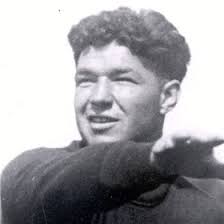 The NFL didn’t maintain official tallies for non-scoring stats until 1932, so the original title holder is, by default, the leading passer from 1932. That honor belongs to Packers legend Arnie Herber. A Green Bay native and Packers fan since childhood, Herber played football locally at the University of Wisconsin before transferring to the now defunct squad at Regis College in Colorado. Upon his return home, he worked as a clubhouse handyman for the Packers. In 1929, he received an invitation from coach Curly Lambeau to try out for the team at the young age of 20. He became one of the NFL’s most dynamic players and helped the Packers win two titles in his first two seasons. He was just 22 when the league began keeping statistics, and the numbers show a young man who was already the premier quarterback of the era.
The NFL didn’t maintain official tallies for non-scoring stats until 1932, so the original title holder is, by default, the leading passer from 1932. That honor belongs to Packers legend Arnie Herber. A Green Bay native and Packers fan since childhood, Herber played football locally at the University of Wisconsin before transferring to the now defunct squad at Regis College in Colorado. Upon his return home, he worked as a clubhouse handyman for the Packers. In 1929, he received an invitation from coach Curly Lambeau to try out for the team at the young age of 20. He became one of the NFL’s most dynamic players and helped the Packers win two titles in his first two seasons. He was just 22 when the league began keeping statistics, and the numbers show a young man who was already the premier quarterback of the era.
If you want an example of how much the game has changed, note that Herber led the league in attempts and yards that season with 101 and 639, respectively. Given the spotty record-keeping of the antebellum NFL, it’s hard to know if he led the league the entire year or just finished the season on top. However, it’s likely he did lead the entire season, as he had the advantage of playing a September 18 game against the Cardinals a week before other teams saw any action. He also had the advantage of playing for one of just two teams that played in 14 games that year. [1]The Bears were the other team. Four other teams participated in 12 games, and two other teams competed in 10 games. It was basically the Wild West at this time in the league’s history. Herber … Continue reading He pushed the record to 6749 yards before his first retirement in 1940. In 1944, the New York Giants convinced him to come out of retirement to provide leadership to a deflated wartime roster. He added 1292 yards to his career total, but by that time his record had already fallen to the next man on the list.
Sammy Baugh (16 years, 2 months as record-holder)
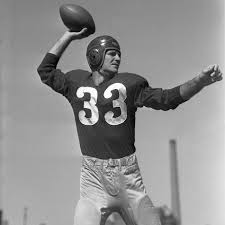 Slingin’ Sammy Baugh was already a legend coming out of college, with many believing he had a bright future in the NFL or MLB. Fortunately for Washington, and for fans of the game’s history, Baugh chose to play in the nation’s capital, where he was drafted sixth overall in 1937. He was an instant star, leading the league in passing yards as a rookie, while taking first team All Pro honors and leading his team to an NFL championship. Despite the hyperbolic praise lavished on many players, few ever actually change the way the game is played. Baugh is one of those rare players, having ushered in a new era in which the quarterback was the field general and undisputed leader of the offense. He deserves at least a modicum of reverence from every great subsequent passer who walked in his footsteps.
Slingin’ Sammy Baugh was already a legend coming out of college, with many believing he had a bright future in the NFL or MLB. Fortunately for Washington, and for fans of the game’s history, Baugh chose to play in the nation’s capital, where he was drafted sixth overall in 1937. He was an instant star, leading the league in passing yards as a rookie, while taking first team All Pro honors and leading his team to an NFL championship. Despite the hyperbolic praise lavished on many players, few ever actually change the way the game is played. Baugh is one of those rare players, having ushered in a new era in which the quarterback was the field general and undisputed leader of the offense. He deserves at least a modicum of reverence from every great subsequent passer who walked in his footsteps.
By 1943, Baugh had picked up two more All Pro selections and another league title. He entered the season as the leader of the defending champions and just 124 yards shy of the record. He picked up the needed yardage in the first game of the season, a 27-0 blowout win over the Brooklyn Dodgers. He kept would-be record-breakers at bay by adding several more outstanding seasons to his illustrious career. By the time he called it quits after the 1952 season, he had amassed 21886 passing yards. His 16 plus years as the record-holder is the second longest reign in history, and it is evidence of his place as the grandfather of the modern NFL quarterback.
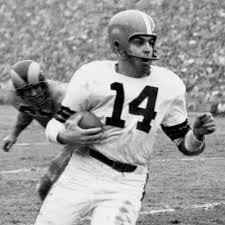 Automatic Otto Graham is among the greatest ever to play the position, and he is certainly the most successful. He famously led the Browns to ten consecutive championship games, winning seven of them. [2]That’s six straight title games and three victories in the NFL, and a four-for-four run in the AAFC. He was unquestionably the best quarterback in the AAFC and was arguably the best player in all of professional football during his career. However, his place in the record books comes with an asterisk. While Graham technically passed for 10085 yards in the AAFC, the NFL does not officially recognize those accomplishments. As far as The Shield is concerned, his professional career began after the 1950 merger. [3]The official story is that the AAFC refused to provide the NFL with game books after the merger, so the elder league refused to include any stats or honors in its record books. Some believe that the … Continue reading Because his record isn’t official, I will not count it as such either; however, I am going to give credit where credit is due and at mention his achievement.
Automatic Otto Graham is among the greatest ever to play the position, and he is certainly the most successful. He famously led the Browns to ten consecutive championship games, winning seven of them. [2]That’s six straight title games and three victories in the NFL, and a four-for-four run in the AAFC. He was unquestionably the best quarterback in the AAFC and was arguably the best player in all of professional football during his career. However, his place in the record books comes with an asterisk. While Graham technically passed for 10085 yards in the AAFC, the NFL does not officially recognize those accomplishments. As far as The Shield is concerned, his professional career began after the 1950 merger. [3]The official story is that the AAFC refused to provide the NFL with game books after the merger, so the elder league refused to include any stats or honors in its record books. Some believe that the … Continue reading Because his record isn’t official, I will not count it as such either; however, I am going to give credit where credit is due and at mention his achievement.
Graham entered 1955, the final year of his storied career, needing just 23 passing yards to take the record away from Baugh. Despite splitting snaps with backup George Ratterman, Graham broke the record in the first game of the season, a home loss to Washington. He finished the season with a career-low 1721 yards, but he went out with a third NFL championship and the unofficial passing record. If we ignore the level of his competition in the AAFC and instead focus on the brevity of his career, the fact that he was able to break the record is incredible. He only played ten seasons of professional football, but he led his league in yards five times, finished second twice, and finished fourth two other times. His swan song was the only year of his career in which he finished lower than fourth, but he did pick up an MVP award to go with his third NFL title ring, which is a fine consolation. By the time he hung up his cleats, Graham had passed for 23584 yards as a pro.
Bobby Layne (4 years, 10 months as record-holder)
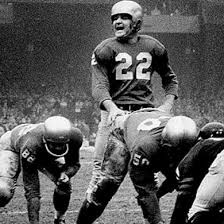 Detroit Lions luminary Bobby Layne is sometimes viewed as the quarterback who bridged the gap between the Graham and Unitas eras. However, the Layne arguably at least shared the early fifties with Graham. He was a hard partying, hard running, hard-nosed player who earned universal respect from teammates and rivals alike. His word was law on the field, and his play backed it up. He captained the ship for the last great NFL teams the city of Detroit has seen, leading the Lions to the promised land in 1952 and 53. [4]He also led the Lions to the 1954 title game, where they lost to a superior Cleveland squad. He was a feared passer and the league’s first great scrambler. Layne had an innate ability to rally his team in high pressure situations, and he is credited as the father of the two-minute drill.
Detroit Lions luminary Bobby Layne is sometimes viewed as the quarterback who bridged the gap between the Graham and Unitas eras. However, the Layne arguably at least shared the early fifties with Graham. He was a hard partying, hard running, hard-nosed player who earned universal respect from teammates and rivals alike. His word was law on the field, and his play backed it up. He captained the ship for the last great NFL teams the city of Detroit has seen, leading the Lions to the promised land in 1952 and 53. [4]He also led the Lions to the 1954 title game, where they lost to a superior Cleveland squad. He was a feared passer and the league’s first great scrambler. Layne had an innate ability to rally his team in high pressure situations, and he is credited as the father of the two-minute drill.
By 1959, he was an elder statesman on the downside of his career. He was one year removed from being traded to the Steelers and two years removed from leading the Lions to the last of his three championships. He came into the season 1809 yards short of the passing record. In the last game of the season, a 35-20 win over the Cardinals, Layne surpassed Baugh, ending the year with 22063 yards. In an age with primitive training and conditioning techniques, as well as outmoded medical technology, Layne’s reckless style of play wore on his body. He played three more abbreviated seasons in Pittsburgh before calling it a career. [5]He started 9 of 12 games in 1960, 6 of 14 in 1961, and 11 of 14 in 1962. By that time, he had accumulated 26768 passing yards.
Y.A. Tittle* (2 years, 1 month as record-holder)
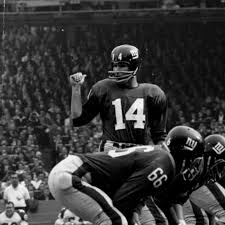 Yelberton Abraham Tittle is an interesting case because he unofficially broke Layne’s passing record in 1962 and then officially broke it in 1964. This is because, like Graham before him, gained a large chunk of yardage in the AAFC. In two seasons with the upstart league’s Baltimore Colts, he threw for 4731 yards that aren’t recognized by the establishment. However, since he was able to play at a high level until he was 38 years old, he eventually claimed the record anyway. In a delightful turn of events, it was an unceremonious exile from the west coast and a sojourn in New York that led to the highest highs of his career. Once the Colts folded after the merger, Tittle became the starter for the 49ers for ten seasons. Shortly before the 1961 season, San Francisco traded the 34 year old passer to the Giants, a move that likely enabled him to break the record.
Yelberton Abraham Tittle is an interesting case because he unofficially broke Layne’s passing record in 1962 and then officially broke it in 1964. This is because, like Graham before him, gained a large chunk of yardage in the AAFC. In two seasons with the upstart league’s Baltimore Colts, he threw for 4731 yards that aren’t recognized by the establishment. However, since he was able to play at a high level until he was 38 years old, he eventually claimed the record anyway. In a delightful turn of events, it was an unceremonious exile from the west coast and a sojourn in New York that led to the highest highs of his career. Once the Colts folded after the merger, Tittle became the starter for the 49ers for ten seasons. Shortly before the 1961 season, San Francisco traded the 34 year old passer to the Giants, a move that likely enabled him to break the record.
Throwing to talents like Del Shofner and Frank Gifford, Tittle seemingly found the fountain of youth, throwing for the fourth, first, and second highest yardage totals of his long career from 1961-63. [6]He also led the Giants to three consecutive championship games, but he was unable to add any hardware to his trophy case. He came into the 1964 season just 227 yards away from officially taking the crown. He managed to do so in the second game of the season, a 24-27 loss in Pittsburgh. By the end of the season, it was clear the legend had little left in the tank, and he retired with 28339 passing yards next to his name in the official record book. His two seasons with the record is the shortest reign of any record-holder.
Johnny Unitas (10 years as record-holder)
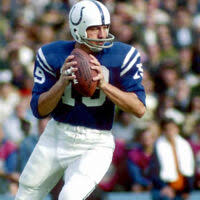 Considered by many to be the greatest quarterback in the long history of the NFL, Johnny Unitas changed the nature of the position indelibly. Like Baugh before him, he took on a larger portion of the offense than previously seen from quarterbacks. He commanded the respect of his teammates and the fear of his opponents, and he was the game’s first real field general. When Unitas was on the field, he called the shots, and the men around him knew to follow (and they followed him to three titles). He was as tough as they come, standing tall in the pocket amid the wanton rage of the enveloping pass rush. He could make any throw and wasn’t afraid to challenge even the greatest defensive backs of the era.
Considered by many to be the greatest quarterback in the long history of the NFL, Johnny Unitas changed the nature of the position indelibly. Like Baugh before him, he took on a larger portion of the offense than previously seen from quarterbacks. He commanded the respect of his teammates and the fear of his opponents, and he was the game’s first real field general. When Unitas was on the field, he called the shots, and the men around him knew to follow (and they followed him to three titles). He was as tough as they come, standing tall in the pocket amid the wanton rage of the enveloping pass rush. He could make any throw and wasn’t afraid to challenge even the greatest defensive backs of the era.
After becoming a full time starter, Unitas finished in the top five in passing yards for eleven consecutive season, skyrocketing his way to the top the record books. Coming off a 1965 season that saw him earn his fourth first team All Pro selection, Unitas was just 1494 yards behind Tittle for the passing record. In the seventh game of the season, a 17-3 win over the Rams, the mythic passer broke the record on a 252 yard passing day. He tacked on another MVP season the following year before suffering a 1968 preseason arm injury that noticeably inhibited his abilities. A few more lackluster seasons and an ignominious exit in San Diego saw Unitas raise his career total to 40239 yards.
Fran Tarkenton (19 years as record-holder)
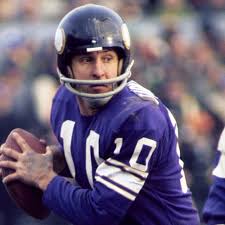 A man of modest stature, even for his era, Fran Tarkenton considered by many to be a scrambler who was too small to effectively play the position. Despite his success in Minnesota, head coach Norm Van Brocklin disapproved of the quarterback’s tendency to leave the pocket to avoid pressure and traded him to the Giants prior to 1967. Tarkenton’s presence elevated the previously downtrodden New York team, and the Mad Scrambler was able to exact revenge over the dominant 1969 Vikings, handing them one of their only two losses of the year. [7]Tarkenton’s Giants also gained the most yards and scored the most points of any team to face the mighty Vikings defense. Minnesota gave up a king’s ransom to get Tarkenton back, and he rewarded them with an MVP bout and three Super Bowl appearances.
A man of modest stature, even for his era, Fran Tarkenton considered by many to be a scrambler who was too small to effectively play the position. Despite his success in Minnesota, head coach Norm Van Brocklin disapproved of the quarterback’s tendency to leave the pocket to avoid pressure and traded him to the Giants prior to 1967. Tarkenton’s presence elevated the previously downtrodden New York team, and the Mad Scrambler was able to exact revenge over the dominant 1969 Vikings, handing them one of their only two losses of the year. [7]Tarkenton’s Giants also gained the most yards and scored the most points of any team to face the mighty Vikings defense. Minnesota gave up a king’s ransom to get Tarkenton back, and he rewarded them with an MVP bout and three Super Bowl appearances.
He entered 1976 needing 1399 passing yards for the record. He broke the record in the middle of the season in a close loss at Chicago, and he finished the year with 2961 yards. He followed that up with two more seasons, including a career-high 3468 effort in his final year at the age of 38. [8]This was the only year of his career he played after the Mel Blount Rule was introduced. Let that sink in. He ultimately put up 47003 passing yards. Despite playing nearly all of his career in the Dead Ball Era, Tarkenton held the record longer than any other quarterback. He’s also the only quarterback whose record successor wasn’t active at any point during his own career. The fact that his records outlasted the Coryell and Walsh revolutions of the Eighties is a testament to how consistently well he performed.
Dan Marino (12 years, 1 month as record-holder)
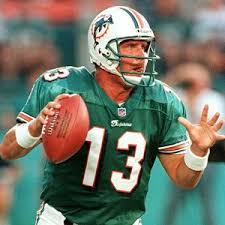 Dan Marino may be the greatest pure passer in the game’s history. Although he was rather statuesque in the pocket, he possessed an incredibly fast mind and a throwing motion as poetic as anything ever penned by Shakespeare. This lethal combination not only allowed Marino to avoid sacks better than anyone in the 100 year history of the league, but it also allowed him to lead an aerial assault on defenses, often forcing them to locate the ball before they were able to diagnose a receiver’s route. Other passers of his era had greater team success, but no one else struck fear in the hearts of defenses the way Marino did.
Dan Marino may be the greatest pure passer in the game’s history. Although he was rather statuesque in the pocket, he possessed an incredibly fast mind and a throwing motion as poetic as anything ever penned by Shakespeare. This lethal combination not only allowed Marino to avoid sacks better than anyone in the 100 year history of the league, but it also allowed him to lead an aerial assault on defenses, often forcing them to locate the ball before they were able to diagnose a receiver’s route. Other passers of his era had greater team success, but no one else struck fear in the hearts of defenses the way Marino did.
In his second season, he produced arguably the greatest season any quarterback has ever had, shattering existing records in Ruthian fashion. After four years in the league, Marino held two of the top three single season passing totals in history. After a decade of play, he owned five of the top fifteen spots. It was clear from early on that the record was his to lose. In just his thirteenth season, Marino broke the record with a 9-yard out to Irving Fryar during a home loss to the Patriots. He tacked on four high-volume seasons after that, for good measure, and retired with a seemingly insurmountable 61361 passing yards.
Brett Favre (7 years, 11 months as record-holder)
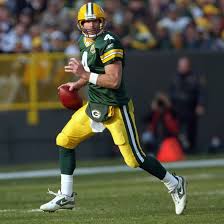 Brett Favre fought through a life-threatening car crash, addiction to medication to battle crippling pain, personal tragedy, and hand of time moving ever-closer to midnight to become one of the greatest and most beloved sports figures in modern history. A welcome respite from cool and calculated quarterbacks of the WCO lineage, Favre was a throwback to those halcyon days of dirt and blood. He exhibited passion and grit reminiscent of Bobby Layne, and his youthful exuberance – even at an old age – was infectious. His arm was as strong as anyone’s in the fabled history of the game, and he wasn’t afraid to use it – for better or for worse.
Brett Favre fought through a life-threatening car crash, addiction to medication to battle crippling pain, personal tragedy, and hand of time moving ever-closer to midnight to become one of the greatest and most beloved sports figures in modern history. A welcome respite from cool and calculated quarterbacks of the WCO lineage, Favre was a throwback to those halcyon days of dirt and blood. He exhibited passion and grit reminiscent of Bobby Layne, and his youthful exuberance – even at an old age – was infectious. His arm was as strong as anyone’s in the fabled history of the game, and he wasn’t afraid to use it – for better or for worse.
In 2007, Favre appeared to be near the end of his career. He was a decade removed from the last of his three consecutive MVP awards, and a dozen years had passed since his only Super Bowl win. Then, at the age of 38, he led the Packers to a 13-3 record and produced one of the greatest seasons of his legendary career. In the fourth quarter of a week 14 blowout victory over the Rams, Favre broke Marino’s record with a 7 yard pass to Donald Driver. After famously moving on to New York, and then to rival Minnesota (where he played at an MVP level at age 40), Favre retired with an astounding 71838 passing yards.
Peyton Manning (2 years, 11 months as record-holder)
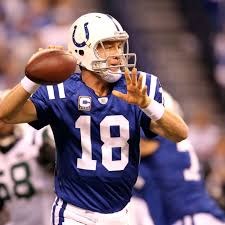 When Manning entered the league, he was a breath of fresh air to fans weary of seeing quarterbacks forced to submit to the will of their coaches. In a post-Walsh league, quarterbacks were generally treated as chess pieces, but the cerebral Manning harked back to an era when the quarterback played the role of Grandmaster. After Favre’s retirement following the 2010 season, Peyton Manning was 17010 yards shy of the record and showed no signs of slowing down. Then he had a series of neck surgeries that threatened to end his career. He lost some of his arm strength and had to relearn how to use his own body in order to advance his already legendary career. After being recruited by John Elway to play for the Broncos, few expected Manning to play well enough for long enough to approach the record. To the surprise of the masses, he strung together three consecutive MVP type seasons, including a 2013 bout that saw him break the season records for yards and touchdowns. He entered the final season of his career trailing the record by 2147 yards.
When Manning entered the league, he was a breath of fresh air to fans weary of seeing quarterbacks forced to submit to the will of their coaches. In a post-Walsh league, quarterbacks were generally treated as chess pieces, but the cerebral Manning harked back to an era when the quarterback played the role of Grandmaster. After Favre’s retirement following the 2010 season, Peyton Manning was 17010 yards shy of the record and showed no signs of slowing down. Then he had a series of neck surgeries that threatened to end his career. He lost some of his arm strength and had to relearn how to use his own body in order to advance his already legendary career. After being recruited by John Elway to play for the Broncos, few expected Manning to play well enough for long enough to approach the record. To the surprise of the masses, he strung together three consecutive MVP type seasons, including a 2013 bout that saw him break the season records for yards and touchdowns. He entered the final season of his career trailing the record by 2147 yards.
In a week ten match against the rival Chiefs, Manning needed just two yards to tie the record. He did so on his second pass of the game, a four yarder to Ronnie Hillman. It was big news when he broke the touchdown record with a four-score performance in a blowout victory over the 49ers in prime time. However, he was less celebrated for breaking the career yardage record because he happened to do so in a losing effort and the worst game of his career. History will remember the game for Manning breaking the record, but those who saw the performance firsthand will likely remember the feeling of seeing a god become human before their eyes. Despite the objectively worst season of his career, Manning picked up a second Super Bowl ring and was able to retire with the titular record (71940 passing yards).
Drew Brees (we’ll see)
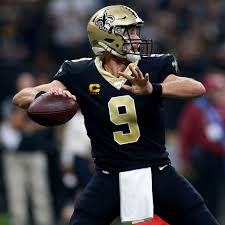 Brees was such a prolific passer at the college level that he was able to convince an NFL team to consider his egregious sin of being short and spend a high draft pick on him anyway. He was a starter by his second season but didn’t look like the future of the Chargers. When the team acquired Philip Rivers in 2004, it seemed to light a fire under the diminutive legend. He improved in every measurable efficiency category, but a shoulder injury late in 2005 made it easy for San Diego to go with the new guy and let Brees go. I doubt anyone could have predicted where his career would go from there. Pairing with coach Sean Payton and playing in the friendly confines of the NFC South, Brees brought hope to a city in despair and a title to a franchise in the doldrums, all the while completely dripping in black ink.
Brees was such a prolific passer at the college level that he was able to convince an NFL team to consider his egregious sin of being short and spend a high draft pick on him anyway. He was a starter by his second season but didn’t look like the future of the Chargers. When the team acquired Philip Rivers in 2004, it seemed to light a fire under the diminutive legend. He improved in every measurable efficiency category, but a shoulder injury late in 2005 made it easy for San Diego to go with the new guy and let Brees go. I doubt anyone could have predicted where his career would go from there. Pairing with coach Sean Payton and playing in the friendly confines of the NFC South, Brees brought hope to a city in despair and a title to a franchise in the doldrums, all the while completely dripping in black ink.
Brees has led the league in passing yards seven times and surpassed 5000 yards five times. All other quarterbacks in history have combined to produce seven 5000 yard seasons. When Manning retired, Brees was 11037 yards shy of the career yardage record. Given how stark the decline is for aging passers, I thought it was possible but unlikely that he would break the record. As he has done to critics his entire career, Brees made my doubts look foolish. Entering his week five matchup against Washington, he needed 201 yards to gain sole possession of the record. He got there by the second quarter. And he did so in exciting fashion, connecting with Tre’Quan Smith on a 62 yard touchdown to put the Saints ahead 26-6. Brees currently has 77576 yards, and—aside from Tom Brady—the only active passer within 20000 yards is the 39 year old who once replaced him in San Diego.
The Future of the Career Passing Yards Record
Any discussion of the future of this record is, of course, speculative. However, it is often a fun exercise to theorize who may one day hold the record. Before getting into that, let’s look at a chart displaying the record’s progression.
As the visual shows, the progression lines for record-breaking quarterbacks has become more and more vertical as the passing game has opened up. We also see that, outside of Baugh and Tarkenton, passers tend to hold the record for a relatively brief period of time. And, with the exception of Tarkenton, every record-holder had some overlap with the quarterback who eventually dethroned him.

Perhaps most importantly, the last four quarterbacks to break the record had long, generally healthy careers. Unless there is a drastic rule change, a quarterback will have to stay healthy and play for a long time in order to see his name at the top of the list. Not only that, but he will have to play very well for almost the entirety of his career. Marino, Favre, Manning, and Brees were consistently great and had consistently high usage rates, which saw their volume stats reach unprecedented levels.
With that in mind, there are three active quarterbacks who are in the running to usurp Brees. Note that I have not included Tom Brady. He currently sits in second place and is 2766 yards shy of the record. He is older than Brees and has fewer yards. I am certain his odds are greater than zero, but I have no idea how to account for a quarterback playing so well at such an age. He is literally unprecedented. [9]This is what I wrote about Brady when I originally penned this article after Manning’s retirement: He’d have to average 4637 yards per season over the next three years in order to break … Continue reading I’ll start with some anecdotal discussion and move into some simple arithmetic.
Before I do that, I want to look back at what I wrote after the 2015 season, because I find the difference between what I wrote and what happened in real life to be hilarious in its wrongness.
Brees is 37 years old and continues to play at a high level for a pass-heavy offense. Since he joined the Saints, he has averaged 4856 yards per season, including four seasons over 5000 yards. He currently trails Manning by 11037 yards, which means he could have the record in 2018, provided he remains both healthy and competent. The catch, of course, is that a 37 year old quarterback is guaranteed neither health or competence for the remainder of his career. Despite the recent media narrative (based largely on his lack of team success), Brees has showed little signs of slowing down recently. However, next year or the year after could end up being the year he finally flips tails.
Stafford’s name is thrown around a lot as a possible successor to the record. He’s an incredibly inefficient passer, but he has averaged 4635 yards per season since finally shaking the injuries that hindered him early on. However, I’m not ready to climb aboard the Stafford train. He’ll be 28 next year and would have to average nearly 4600 yards per season till he reaches 37 in order to break the record. While this is mathematically possible, one major thing keeps me from buying it: I’ve watched him play, and he’s not good enough to be around when he’s 37.
The most highly touted prospect since Manning himself, Luck began his career like a true gunslinger. He averaged 4319 yards per season over his first three years, which put him on pace to break the record in about 17 seasons. Then 2015 came around, and he missed 9 games to injury. If he can bounce back healthy for most of his remaining career and can continue to air it out over that time, it isn’t unrealistic to count him out. When you consider the trend the NFL has followed with regards to rules affecting the passing game, it stands to reason that Luck will have an easier time catching Manning than will Brees or Stafford.
Let’s take a look at the same chart from above with the three quarterbacks added.
I’ll use some very simple math to estimate their chances of breaking the record. I’m going to borrow Bill James’s Favorite Toy model to do so. It’s pretty simple:
- Calculate how many yards each player needs to reach the record (NEED).
- Estimate the remaining years left in his career (24 – 0.6 * age)
- Calculate a three year weighted average from the previous three seasons [(year n-1 * 3) + (year n-2 * 2) + (year n-3)] / 6
- Calculate a Projected Remaining Total (PRT) by multiplying the numbers from steps 2 and 3.
- Find the percent likelihood the player will match the record (PRT / NEED) – 0.5
Brees needs 11037 yards. He’s 37, giving him an estimated 1.8 years left. His three year weighted average is 4946, giving him a Projected Remaining Total of 8903 yards. That gives Brees an estimated (8903/11037 – 0.5 =) 30.7% chance at the record.
Stafford needs 45964 yards with 7.2 expected years left. His three year weighted average is 4325, giving him a PRT of 31140 and a 17.7% chance at the record.
Luck needs 57102 yards with 8.4 estimated years left. His three year weighted average (omitting his injury season) is 4255, giving him a PRT of 35738 and a 12.6% chance at the record.
The formula, as James suggests, is fun to toy around with, but it does produce some intuitive results. It gives Brees a pretty high shot at the record (given that records are, by their very nature, unlikely events, a 30.7% chance is a massive one). It also rewards Stafford and dings Luck for their rookie year ages. Stafford, who came into the league at 21, posted a 5000+ yard season when he was 23. Luck, on the other hand, went pro at 23. It’s worth noting, however, that Luck did have more yards by 23 than Brees, and he does figure to play out the rest of his career in an environment more conducive to passing.
Since that time, Brees broke the record in 2018 (as I said he could but only gave him a 30.7% chance to do, based on the numbers), Stafford had a low usage season followed by an abbreviated season, and Luck realized you have to be crazy to play professional football.
Stafford, of course, remains one of the more likely candidates. Jameis Winston once looked like he had a shot, but now he is backing up the yardage king. Matt Ryan isn’t especially young, but he has the style of play that lends itself to longevity in the modern game. My personal hope is to see Patrick Mahomes take the crown some distant day, but he has to be considered a very long shot with only 9623 yards to his name.
Brees is still playing, but I have to have some number on which to base the Favorite Toy model. So let’s just say he decides to quit football today and start investing in habitats on mars or something like that.
Right now, the above formula gives Stafford 4.8 years left in his career. With 36254 yards to go just to get where Brees is right now, he has a 7.1% chance to own the record.
Ryan is 25940 yards shy of the record and expected to play another 3 years.With his production in his last three seasons, the Favorite Toy model gives him a 4.2% chance to break the current record. Obviously players tend to just fall right off a cliff rather than steadily decline, but I see Ryan playing longer than that. I am not sure if the model should be updated to account for modern medicine.
For fun: Mahomes is 67953 yards short and is projected to play nine more seasons at a rate of 4751 yards per year. That would still put him short of the record. However, and interestingly, the model likes his combination of youth and production, giving him 12.9% odds to break the current record.
I have no idea who is going to hold the record next. In all likelihood, the next quarterback to hold the record is active this season.
I’ll save further discussion of the future for the future. For now, let’s appreciate the road that got us here.
References
| ↑1 | The Bears were the other team. Four other teams participated in 12 games, and two other teams competed in 10 games. It was basically the Wild West at this time in the league’s history. Herber still led the league in yards per game, but his 45.6 to 44.9 advantage over Walt Holmer barely earns him the top spot. |
|---|---|
| ↑2 | That’s six straight title games and three victories in the NFL, and a four-for-four run in the AAFC. |
| ↑3 | The official story is that the AAFC refused to provide the NFL with game books after the merger, so the elder league refused to include any stats or honors in its record books. Some believe that the NFL was simply embarrassed by the dominant Cleveland Browns and refused the AAFC’s stats out of spite. No one outside of the decision makers knows for sure, but it is at least worth mentioning that the AAFC was somewhat inferior competition, on average. Yes, the Browns were likely the best team in all of professional football, and the 49ers were good too. However, the average NFL team was much better than the average AAFC squad. The AAFC was incredibly top-heavy; of the thirteen Hall of Fame players on AAFC rosters, six played for the Browns, and three more for the Yankees. That’s 69% of HOF players on two teams. If you include Hall of Fame coaches Paul Brown and Ray Flaherty, that number becomes 73% (they coached the two aforementioned teams). Cleveland was a great team in the NFL, but it was a juggernaut in the AAFC. |
| ↑4 | He also led the Lions to the 1954 title game, where they lost to a superior Cleveland squad. |
| ↑5 | He started 9 of 12 games in 1960, 6 of 14 in 1961, and 11 of 14 in 1962. |
| ↑6 | He also led the Giants to three consecutive championship games, but he was unable to add any hardware to his trophy case. |
| ↑7 | Tarkenton’s Giants also gained the most yards and scored the most points of any team to face the mighty Vikings defense. |
| ↑8 | This was the only year of his career he played after the Mel Blount Rule was introduced. Let that sink in. |
| ↑9 | This is what I wrote about Brady when I originally penned this article after Manning’s retirement: He’d have to average 4637 yards per season over the next three years in order to break Manning’s record. He’ll need even more if Brees breaks the record first. It’s not impossible, but I don’t see Brady putting up that kind of volume when he’s 41. Brady went on to play like the best QB in football in 2016 (age 39), lead the league in yards in 2017 (40), gain 4355 yards in 2018 (41), and throw in another 4057 last year (42). I am often wrong, and sometimes significantly so. |
